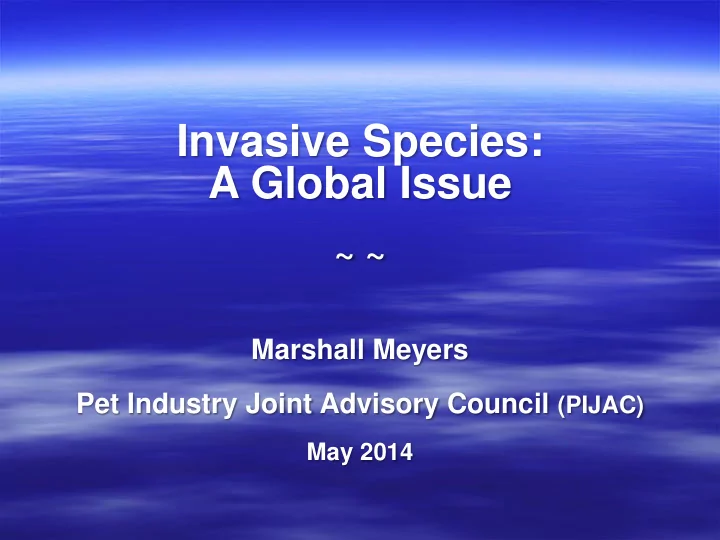

Invasive Species: A Global Issue ~ ~ Marshall Meyers Pet Industry Joint Advisory Council (PIJAC) May 2014
Invasive Species Major and increasing driver to biodiversity loss Acknowledged as global issue Impacts native species, weakens ecosystems, destroys habitat, affects human health Which industry handles more specimens of more non-native species than the pet industry?
Global Movement Argentina France Singapore Australia Guatemala Solomon's Barbados Germany South Africa Bahrain Hong Kong Spain Bahamas India Sri Lanka Bangladesh Indonesia Surinam Belgium Italy Philippines Brazil Japan Tanzania Canada Kenya Thailand Chile Maldives Tonga China Mauritius Tunisia Columbia Netherlands UAE Congo Ubekistan Nicaragua Cook Islands UK Paraguay Costa Rico USA Denmark Peru Vanuatu Dominican Republic Puerto Rico Venezuela El Salvador Russia Yemen Egypt Saudi Arabia Entrea Senegal Fiji
Pet Release Pathway (Generic) Internet Captive Breeding Collection Foreign Exporters Import Wholesalers Captive Breeding/ Wholesalers Collection Unlicensed Sales Retailers Public (Consumers) Notes: Dashed lines indicate infrequent sales/movement. Thick lines indicate primary sales/movement. Likelihood of release in red. Green box represents the natural environment.
Lacey Act 1973 USFWS Proposed all non-natives “injurious” under 16 USC § 42 1975 PIJAC called for – FACA committee – Science based listing criteria/Process – Publish criteria/Transparency – Licensure system for commercial importers – Screening/Risk assessment – Emergency Response Network – Education/Outreach
Lacey Act 1994 PIJAC recommended risk-based screening process for “first time introductions” 2001 National Invasive Species Management Plan calls for Rapid Screen Process 2014 Ecological Risk Screen a “reality”
Lacey Act Shortcomings Out of touch with a global economy One size fits all Requires modernization Lacks regulatory flexibility Insufficient funding and staffing Listing process time consuming Effective prevention Regulatory/Non-Regulatory
Industry Involvement Opposes poorly crafted laws/regulations Promotes science-based decision-making Regulatory/non-regulatory initiatives Industry education/outreach initiatives Requests to share trade data Dealing with unwanted animals/plants
Non-Regulatory Initiatives Two MOUs – Education/outreach – Ecological Risk Screen
Current poster child
Could this be our next poster child? Or this?
Habitatttude DOI/PIJAC MOU Revisited Brand name Revitalize/Redirect Rebrand/Target messaging/Brand compliance Expand beyond aquatics Redesign website/Relevant content Utilize social marketing Produce useable outreach/education materials Collaborate on education/public awareness Engage more partners Inadequate funding and staffing
Habitattitude tm Proactive campaign to ensure Wise pet choices (Habits) Protect environment (Habitats) from impacts of unwanted pets Help pet owners find alternatives to release of their pets (Attitudes) “ Select the right pet! Do right by your pet. Do right by our environment.”
Codes of Conduct Best Management Practices
Non-Regulatory Initiatives Two MOUs – Education/outreach – Ecological Risk Screen
RISK SCREENING Risk-based comprehensive screening system Intentional Introductions Review Report to Congress (1994) National Invasive Species Management Plan (2001) USGS, ANSTF, ISAC, NISC experimented FWS Ecological Risk Screen under final review •
FWS Ecological Risk Screening Tool Rapid risk assessment designed to evaluate potential invasiveness (establishment and impact) of non-native species not yet in trade – “first time introduction” Relies on – Current scientific information – Numerous invasive species databases – Climate matching technology – Risk management options – Detailed administrative record – Peer review
Tools Available (Databases) Fishbase CORPI USGS NAS IABIN APFISN OISD GISD ENV.GOV DAISIE NAISN FISNA FAO APASD NIMPIS GISIN SERC NISIC Europe-aliens GRIS DIAS Inter-American CABI ISC NANSC Biodiversity Network NOBANIS NIS iz.carnegiemnh.org GBIF NAS Google scholar NISbase IABIN Google Earth AIRD BioNet NISS KGS Mapper CIESM RBIC AFS AIRIES InfoNatura
6 Test Species Risk Assessment Elements – Overall Risk Assessment Category: High History of Invasiveness: High Climate Match: High Certainty of Assessment: High Prussian carp Stone Moroko Roach Wels Catfish Crucian carp Nile Perch
Industry/Government Collaboration
Ecological Risk Screen Outcomes Governments and industries determine whether science-based risk of a nonnative species impact on native species and ecosystems, is: Uncertain Low, or High Governments can use results to regulate Industries can use results to keep “green” Both groups can work together to design biosecurity protocols http://www.fws.gov/injuriouswildlife/Injurious_prevention.html
What is the benefit? Voluntary non-regulatory approach to preventing potential invasive species from being imported. FWS provides recommendations on the risk level of species and makes the information publically available. Individuals use ERS Summary reports to determine whether or not to import the species and, if so, adopt biosecurity safeguards. States can decide for themselves whether to regulate a species or work with industry on alternatives. Open door policy – bring more tools to the toolkit
Potential Partners Pet Industry Joint Advisory Council (PIJAC) ✔ Association of Fish and Wildlife Agencies (AFWA) (representing the 50 States) ✔ Association of Zoos and Aquariums (AZA) ✔ National Aquaculture Association (NAA) American Sportsfishing Association (ASA) Alliance of Marine Mammal Parks & Aquariums Other Federal Agencies and Bureaus? Individual states Other Industry partners?
Marshall Meyers Pet Industry Joint Advisory Council (PIJAC) marshall@pijac.org 202-466-8271
Recommend
More recommend